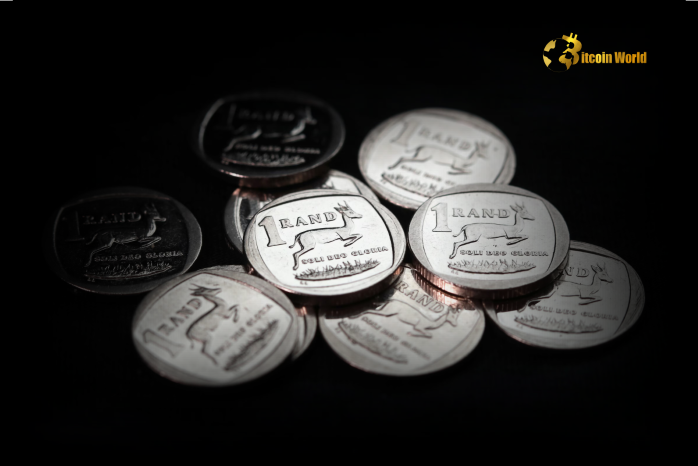
Ex-Binance Boss Changpeng Zhao reveals his crypto portfolio
U.Today
You can visit the page to read the article.
Source: U.Today
Disclaimer: The opinion expressed here is not investment advice – it is provided for informational purposes only. It does not necessarily reflect the opinion of BitMaden. Every investment and all trading involves risk, so you should always perform your own research prior to making decisions. We do not recommend investing money you cannot afford to lose.
Nasdaq Files For HBAR ETF Amid Surge of SEC Applications for Alternative Cryptocurrency Funds

Nasdaq’s recent filing to list an ETF focused on Hedera’s HBAR token underscores the growing interest in altcoin investment products. The ETF trend reflects a broader acceptance of cryptocurrencies within U.Today

Rand’s Remarkable Rise: Will South African Economic Data Fuel Further Gains?
The South African Rand (ZAR) has been showing impressive strength recently, capturing the attention of forex traders and economists alike. Ahead of crucial South African economic data releases, the currency is demonstrating resilience. But what’s driving this upward momentum, and can it be sustained? Let’s dive into the factors influencing the Rand and what to expect from the upcoming economic figures. Why is the South African Rand Showing Strength? In the world of emerging market currencies , the Rand often experiences volatility. However, in recent sessions, it has defied expectations by exhibiting notable strength. Several factors are contributing to this positive trend: Global Risk Sentiment: Improved global risk appetite often benefits emerging market assets, including the Rand. When investors are feeling optimistic about the global economy, they tend to allocate capital to higher-yielding, albeit riskier, markets like South Africa. Commodity Prices: South Africa is a significant exporter of commodities. Rising prices for key commodities like platinum, gold, and coal can bolster the Rand by improving the country’s trade balance and overall economic outlook. Local Factors: While global factors play a significant role, domestic elements are also at play. Expectations around South Africa’s fiscal policy and potential reforms can influence investor sentiment towards the Rand. Carry Trade Appeal: The ZAR exchange rate can be attractive for carry trades, where investors borrow in low-interest-rate currencies and invest in higher-yielding ones. South Africa’s relatively higher interest rates can make the Rand appealing for such strategies. Decoding the Anticipated South African Economic Data Release The current strength of the Rand is largely attributed to anticipation surrounding upcoming South African economic data. But what specific data points are market participants keenly watching, and why are they so important? Key Economic Indicators in Focus: Inflation Rate: Inflation data is always a critical indicator. Higher-than-expected inflation could prompt the South African Reserve Bank (SARB) to consider further interest rate hikes to curb price pressures. This, in turn, could make the Rand more attractive to investors seeking higher yields. Conversely, lower inflation could ease pressure on the SARB and potentially lead to a less hawkish stance. Gross Domestic Product (GDP) Growth: GDP figures provide a snapshot of the overall health of the South African economy. Stronger-than-anticipated GDP growth would signal economic resilience and could boost confidence in the Rand. Weaker growth, however, could raise concerns about the economic outlook. Manufacturing and Mining Production: Data on manufacturing and mining output is crucial for South Africa, given its reliance on these sectors. Positive figures would indicate robust economic activity in these key areas, supporting the Rand. Retail Sales: Retail sales data offers insights into consumer spending and domestic demand. Strong retail sales suggest a healthy consumer sector, which is a positive sign for the economy. Trade Balance: The trade balance reflects the difference between a country’s exports and imports. A trade surplus (exports exceeding imports) is generally positive for a currency, while a deficit can be negative. The release of this economic data release is a pivotal moment for the Rand. Positive surprises could solidify its recent gains and potentially propel it even higher. However, disappointing figures could trigger a reversal, leading to Rand weakness. How Could the Data Impact the ZAR Exchange Rate? The ZAR exchange rate is highly sensitive to economic news. Here’s a look at potential scenarios: Economic Data Outcome Potential Impact on ZAR Market Reaction Stronger-than-expected Inflation, GDP, Production, Retail Sales Rand Strengthens Significantly Increased demand for ZAR, potential for further gains In-line with Expectations Moderate Rand Strength or Consolidation Market may have already priced in expectations, limited immediate reaction Weaker-than-expected Inflation, GDP, Production, Retail Sales Rand Weakens Concerns about economic outlook, potential for ZAR depreciation It’s important to remember that market reactions can be complex and influenced by various factors beyond just the data itself. Global events, shifts in risk sentiment, and technical trading factors can all play a role. What Does the Future Hold for the Rand? Considering the Rand Forecast Predicting currency movements is never an exact science, but we can consider some factors that will influence the Rand forecast in the near term: Global Economic Conditions: The global economic outlook will remain a major driver for emerging market currencies like the Rand. Global growth, inflation trends, and interest rate policies of major central banks will all have an impact. South African Economic Reforms: Progress on structural economic reforms in South Africa, such as addressing energy security, improving infrastructure, and tackling corruption, could significantly boost investor confidence and support the Rand in the longer term. Commodity Market Dynamics: The trajectory of commodity prices will continue to be a key factor for the Rand, given South Africa’s commodity export dependence. Political Stability: Political stability and policy consistency are crucial for investor confidence. Any political uncertainty could weigh on the Rand. Actionable Insights: For traders and investors monitoring the Rand, keeping a close eye on the upcoming economic data releases is paramount. Understanding market expectations and potential reactions to different data outcomes is key to navigating potential trading opportunities. Furthermore, staying informed about global economic trends and South Africa’s domestic policy developments is essential for a comprehensive view of the Rand’s prospects. Conclusion: Riding the Rand Wave – Is it Sustainable? The South African Rand’s recent strength is an encouraging sign, fueled by anticipation of positive economic data and a generally supportive global backdrop. However, the sustainability of this rally hinges on the actual economic data releases meeting or exceeding expectations. While the current momentum is palpable, it’s crucial to approach the market with informed caution. The Rand, like all emerging market currencies, remains susceptible to shifts in global sentiment and unexpected economic developments. Monitoring the data closely and understanding the broader economic context will be vital for anyone looking to navigate the Rand’s journey ahead. To learn more about the latest Forex market trends, explore our article on key developments shaping currency valuations and global economic outlook. U.Today











